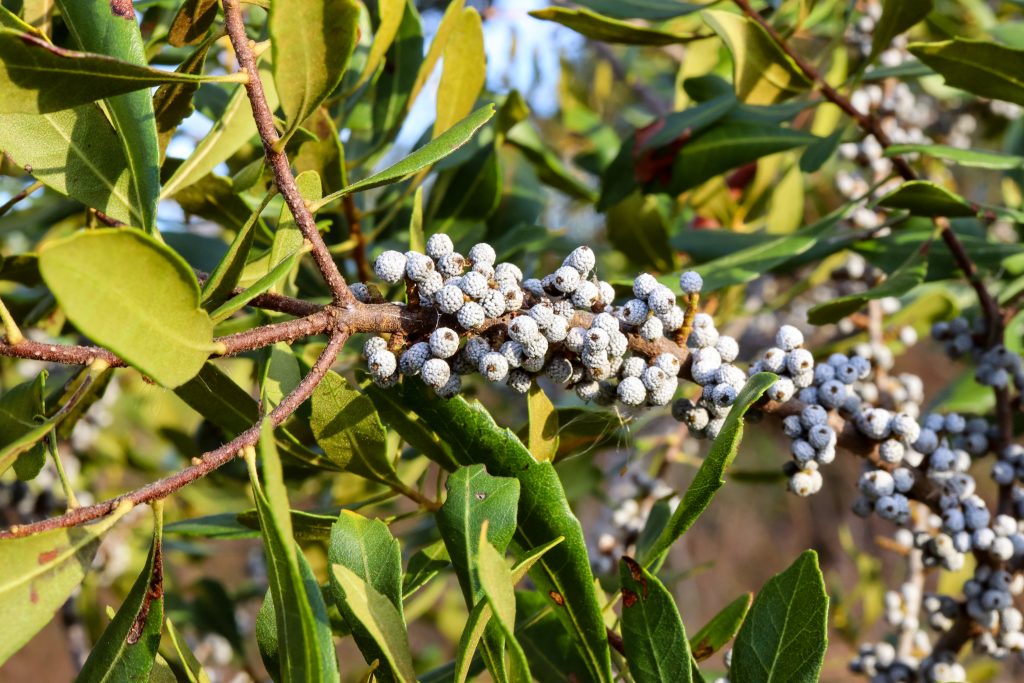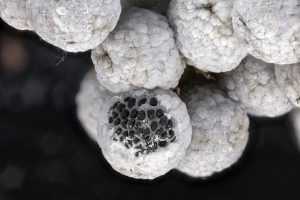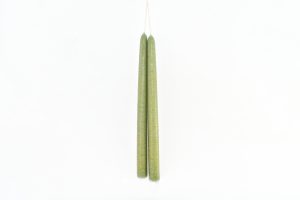
Light, Sleep and Botanical Knowledge: Candleberries in Early America
Light is one of the most important external factors to affect sleep. It is known to regulate the body’s circadian rhythm, the internal clock which tells us when to be alert and when to rest, and to affect the production of the sleep-promoting hormone, melatonin. Today, we are warned about the dangers of exposure to blue light at bedtime, while proponents of the two-sleep model with regards to pre-modern sleep, suggest that heightened exposure to artificial lighting was a crucial factor in the decline of this divided sleep pattern.
While we might suppose that the sleep habits of people in the past were more closely structured around nature’s seasonal rhythms and the availability of natural light, sources of artificial light, such as candles, oil lamps and fire light, nevertheless enabled early modern people to extend their waking activities. It was not uncommon for people to stay up late working, studying or socialising. In his youth, the presbyterian minister Henry Newcombe (1627-1695) fashioned a homemade candlestick holder from vellum which he nailed to his bedhead to allow him to read before going to sleep (Handley 2016, 91). Craftsmen such as sugar bakers and brewers conducted much of their work by candlelight, and were listed as major consumers of candles in the records of eighteenth-century tallow-chandlers (Cockayne 2007, 147). Tallow-chandlers made and sold candles created by dipping cotton wicks into inedible mutton or beef tallow collected from butchers and domestic kitchens. Such candles were cheaper and more widely used than wax candles and were a key source of artificial light in early modern England.
In early America, there was a less plentiful supply of animal tallow from which to make candles prior to the introduction of domestic livestock farming by European colonists (Anderson 2004). The English writer William Strachey, for instance, who served as secretary and recorder for the Jamestown colony in Virginia, noted that indigenous people did not ‘breed Cattell nor bring up tame poultry’ in their villages. While tallow candles could be imported, colonists looked for other, more readily available alternatives to prolong their evening activities. Strachey stated that native Virginians made ‘Candells of the fattest splinters of the Pyne or ffirre tree, which will give a good cliere light and burne strongly’. Another option was the use of candleberries from native myrtle or bayberry plants (Myrica cerifera & Myrica pennsylvanica). These dark blue coloured berries are coated with a layer of wax which, when boiled, rises to the surface, and may be skimmed off and used to make candles.

Northern bayberry (Myrica pennsylvanica) showing wax coating.
In his History and Present State of Virginia (1705), Jamestown official Robert Beverley stated that ‘the melting of these berries is said to have been first found out by a Surgeon in New-England who perform’d wonderful Things, with a Salve made out of them’, and he suggested this discovery was ‘very modern’. By the early eighteenth century, however, the use of such berries to make candles was widely discussed in botanical and travel literature.
Candleberries were found, reported Beverley, ‘at the mouth of their Rivers, and all along upon the Sea and Bay, and near many of their Creeks and Swamps’. The collection of bayberry wax was thus a geographically specific activity, which depended upon the environmental conditions of a particular landscape. Yet candleberry candles were also sold and marketed more widely. The English writer, diarist and horticulturist John Evelyn stated that such candles were even being exported to England, writing that they ‘are now frequently brough hither to us’.
English naturalist Mark Catesby echoed Beverley in writing that the native myrtle plant was found mainly on the coast, and he outlined the annual migration of those wanting to gather candleberries during their period of maturation in November and December. He stated that at this time,
a man with his family will remove from his Home to some Island or Sandbanks near the sea, where these Trees most abound, taking with him Kettles to boil the Berries in. He builds a Hut with Palmeto Leaves, for the shelter of Himself and Family while they stay, which is commonly Three or Four Weeks.
To procure the berries, Catesby stated, ‘the man cuts down the Trees, while the children strip off the berries into a porridge pot’. Candleberries thus had additional consequences for the sleeping arrangements of some in early America, as these families reportedly slept in temporary shelters through cold winter conditions on an annual basis. This pattern of migration also suggests that the collection of candleberry wax was not merely for the purpose of subsistence, but that it would be sold on to support the household economy.
Once the berries had been boiled and the wax collected, the Finnish-Swedish botanist Pehr Kalm described it as looking ‘like common tallow, or wax, but has a dirty green colour; it is for that reason melted over again, and refined, by which means it acquires a fine and pretty transparent green colour’. As well as being visually appealing, candleberry candles had a pleasant smell which made them far superior to tallow candles. Evelyn wrote that they gave ‘not only a very clear and sufficient light, but a very agreeable smell’. Beverley likewise stated that ‘if an Accident puts a Candle out, it yields a pleasant Fragrancy to all that are in the Room; insomuch, that nice People often put them out, on purpose to have the incense of the expiring Snuff’. Since candles were often burned in chambers prior to sleep, the pleasant smell of candleberry wax would likely have been viewed as encouraging peaceful rest. Soporific scents were characterised by their sweet and pleasant smells which would calm the mind and sooth the senses. By contrast, the Norfolk clergyman James Woodforde (1740-1803), noted that the ‘intolerable smoke and stink’ from his regular night candles, probably made of tallow, disturbed his sleep. Candleberry wax offered a sweeter-smelling alternative.

Contemporary bayberry taper candles showing their green colour.
Candles made from such wax were also found to withstand the extreme heat of North American summers which were unfamiliar to European colonists. Kalm stated ‘Candles of this kind do not easily bend, nor melt in summer as common candles do’, while Beverley likewise commented that they ‘are never greasie to the Touch, nor melt with lying in the hottest Weather’. Colonists thus sourced an alternative material for lighting which was better suited to their new environment than the tallow they were used to. Given their resistance to melting, candleberry candles also lasted longer than tallow candles.
Even when tallow became more widely available in colonial America, candleberry candles were valued more highly than those made of tallow. Kalm wrote that ‘In Philadelphia they pay a shilling Pennsylvania currency, for a pound of this tallow [from candleberries]; but a pound of common tallow only came to half that money’. The effort of collecting candleberries, as well as the large number of berries required to make one candle, meant it was a time-consuming task, which would have further inflated the cost of such candles. Kalm stated that he had heard of similar candles being made in Sweden, though he did not specify the type of native berries in use there. Yet, he wrote,
at present they do not make so many candles of this kind, if they can get the tallow of animals, it being too troublesome to gather the berries. However, these candles are made use of by poor people, who live in the neighbourhood of a place where the bushes grow, and have not enough cattle to kill, in order to supply them with a sufficient quantity of tallow.
In early America too, it is likely that many colonial families would have made their own candles, for which candleberries offered a cheaper, better smelling, and slower-melting option than tallow, in turn shaping bedtime experiences and routines. The use of candleberry wax to extend an evening’s activities, enabling early modern people to continue to read, work or socialise into the night, drew on a place-based knowledge of botanicals, and processes of material experimentation which demonstrate the extent to which early modern sleep practices were environmentally situated.
References:
Anderson, Virginia DeJohn. 2004. Creatures of Empire: How Domestic Animals Transformed Early America. Oxford: Oxford University Press.
Cockayne, Emily. 2007. Hubbub: Filth, Noise and Stench in England, 1600-1770. New Haven & London: Yale University Press.
Handley, Sasha. 2016. Sleep in Early Modern England. New Haven & London: Yale University Press.








0 Comments